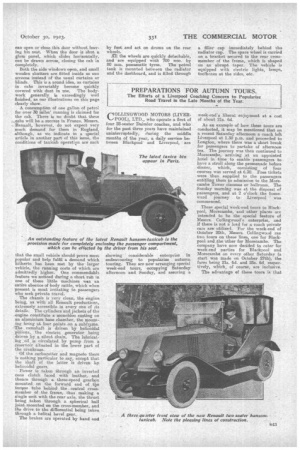• THE LATEST IN SMALL HANSOM TAXICABS.
Page 28

Page 29

If you've noticed an error in this article please click here to report it so we can fix it.
A new French Vehicle in which Provision is Made for Carrying Two Passengers.
APARTICULARLY attractive little taxicab is being turned out by the Renault Co. in France. This is a twopassenger vehicle of the ft-out-entrance hansom-cab type. It is mounted on the standard 6 h.p. chassis, which has a four-cylinder engine, with a bore and stroke of 58 mm. and 90 min. reepectively, and conveys Its power through a three-speed gearbox.
Many attempts have been made in the past to adapt the hansom-cab type of body to a motor-vehicle chassis, but the results have nearly always been clumsy
and unsightly, One eVen remembers the efforts of a certain manufacturer who went so far as to dispose the driver's seat at the back of the roof, with a steering column about 10 ft, long.
The latest Renault production is certainly an artistic success, -and on account. of the exceptionally low cost at which it can be run it should make a strong appeal to the cab owner.
The door of the cab, which is in the form of an apron, hinges from the bottom and opens forwards. As can be clearly seen in one of our illustrations, the driver can open or close this door without leaving his seat. When the door is shut a glass panel, which slides horizontally, can be drawn across, closing the cab in completely. Both the side windows open, and small wooden shutters are fitted inside as sun screens instead of the usual curtains or blinds. This is a sound idea, as curtains in cabs invariably become quickly covered with dust in use. The bodywork generally is exceedingly well finished, as our illustrations on this page clearly show. A consumption of one gallon of petrol for over 50 miles' running is claimed for the cab. There is no doubt that these eabs will be a success in France. Messrs. . Renault., however, do not expect very much demand for them in England, although, as we indicate in a special article in another part of this issue, the conditions of taxicab operation are such
that the small vehicle should prove most Popular and help fulfil a demand which hitherto has been met by thelarger vehicle, the running costs of which are admittedly higher. One commendable feature we noticed during a short run In one of these little machines wets an entire absence of body rattle, which when present is most irritating to passengers who seek private travel.
The chassis is very clean, the engine being, as with all Renault productions, extremely accessible in every one of its details. The cylinders and jackets of the engine constitute a monobloe casting on .an aluminium base chamber, the mount.ing being at four points .on subframe. The camshaft is driven by helicobial • .ptnions,. the electric generator, being driven by a silent chain. The lubricating oil is circulated by pump from a reservoir situated in the lower part of the crankcase.
Of the carburetter and magneto there is nothing particular to say, except that the shaft of the latter is driven by helicoidal gears. • Power is taken through an inverted cone clutch faced with leather, and thence through a three-speed gearbox mounted on the forward end ofthe torque tube behind the _ central crossmember of of the frame, thus making a single unit with the rear axle, the thrust being taken through a spherical bail joint mounted on the cross-member, and the drive to the differential being taken through a helical bevel gear. The brakes are operated by hand and by foot and act on drums on the rear wheels.
ll the wheels are quickly detachable, and are -equipped with 700 mm. by 80 mm. pneumatic tyres. The petrol tank is mounted between the radiator and the dashboard, and is filled through a filler cap immediately behind the radiator cap. The spare wheel is carried on a bracket secured to the rear crossmember of the frame, which is shaped on an abrupt taper. The vehicle is equipped with electric lights, lamps, toolboxes at the sides, etc.




































